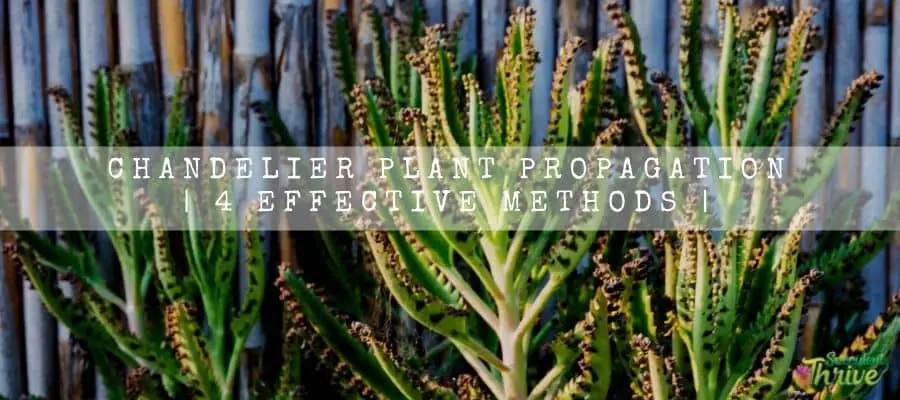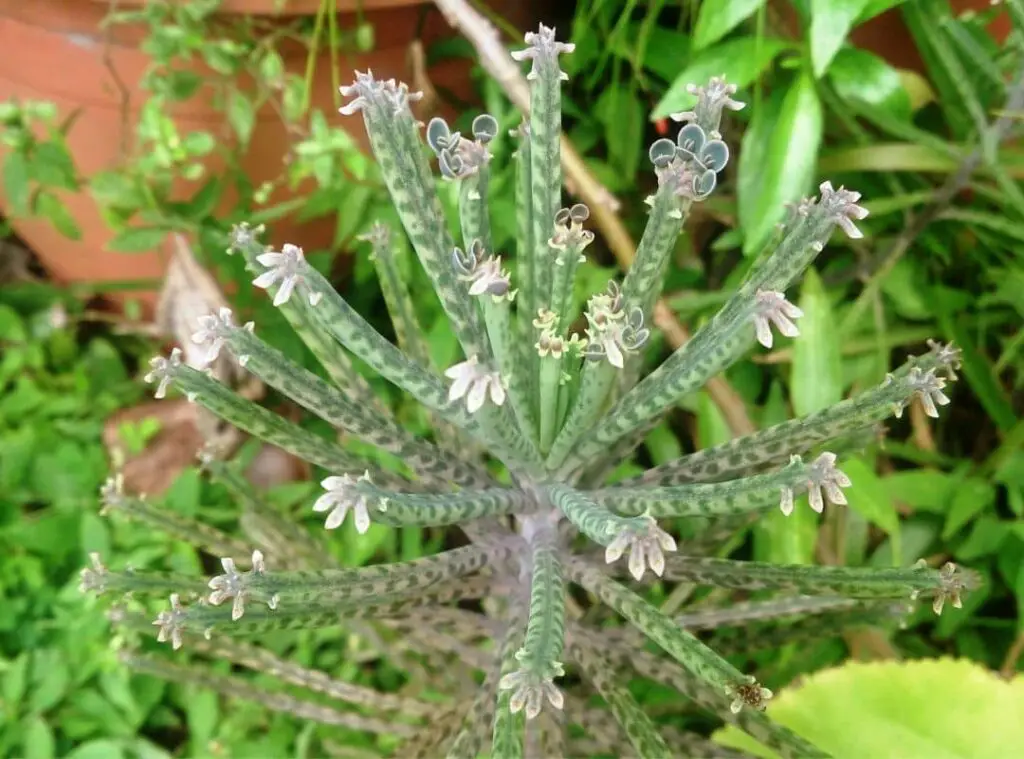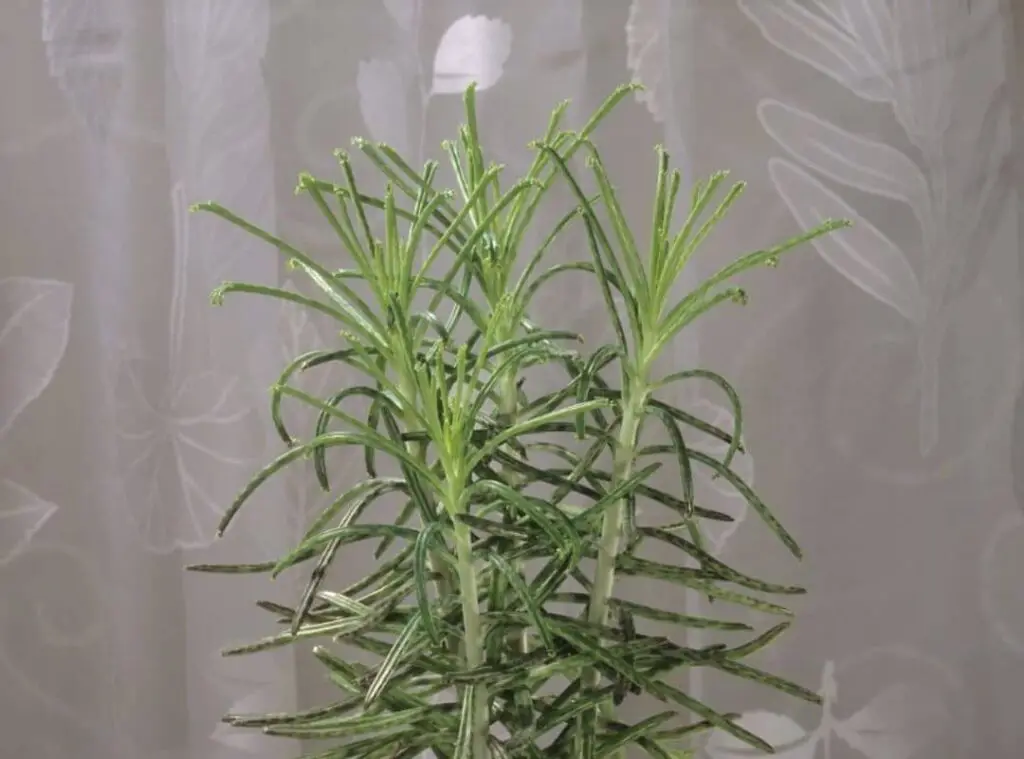Cuttings is the famous Chandelier plant propagation method. Further the best time to conduct the propagation of the Chandelier plants would be summer.
However, they can propagate naturally too. The plantlets of their leaf edges will form roots when they fall on the ground.

Chandelier plant
Chandelier plants have branches that form in all directions and thus, they have got the name Chandelier plant.
You could see how Chandelier plants each leaf comprising tiny plantlets. They further have roots which tend to form in a trailing manner.
Chandelier plants are native to Madagascar and could be commonly spotted in dry climate conditions.
They are versatile and resilient plants. They spread rapidly as their plantlet’s leaves are thin and long. They could survive anywhere they land.
Chandelier plants go by the common name called mother of millions. They have inherited this name as they have so many plants which line the leaves.
If you mistakenly kill one of those, they will tend to grow in another place closer to there. It would be very hard to kill them particularly in some areas. In fact, they are known as weed or invasive plants due to that feature.
Chandelier plant propagation through stem cuttings
- First you should arrange a well-draining soil mix, a pair of sharp scissors and a rooting hormone.
- To proceed with you need to first cut a piece of stem cutting of the Chandelier plants whilst leaving a few leaves on it.
- The stem cutting length should be about 10-12 cm in length.
- Next, leave them in a warmer place where they can develop callousness.
- Optionally you may dip the cuttings in a rooting hormone when they are fully dry and calloused.
- Next place the stems in the soill.
- Avoid leaving the specimen in direct sunlight and water them lightly when their top layer of the soil is dry.
- They start to develop roots within a couple of weeks.
- When they are about 2-3 cm long, you may transplant them in a new pot.
Chandelier plant propagation through leaf cuttings
You may do the same steps as the cuttings method when propagating the Chandelier plants through leaf cuttings.
- You need to first trim the leaves which look healthy, plump and vigorous.
- Then place the cut leaves in a warmer place where there will be a good air circulation available.
- When they are entirely dry, you may insert them in a sand bowl in a diagonal manner.
- Root formation will take place within 10-30 days.
- However, this method is time consuming and you cannot always rely on the results of the success of the propagation as well.
Do they produce seeds?
Chandelier plants produce seeds, and they are useful for the reproduction purposes of the plants as well.

Do they produce offsets?
Chandelier plants produce offsets, and you may use their offsets also to propagate them.
- They will take a longer time to produce offsets.
- However when they do, you can simply take them off while using a sharp knife.
- Next, clean the offsets and place them in a potting medium which is well draining. .
- Before you plant them, ensure that you let them become callous and only then plant them in a free draining soil mix.
How to treat after propagation
Light requirement of the Chandelier plants.
Full sunlight to semi shade would be ideal conditions for the Chandelier plants to grow well.
Hence , always place them in a brightly lit spot at your home if you grow them as houseplants. Refrain in exposing them under direct sunlight especially in summer as it would be harmful for the Chandelier plants.
In fact, it would make the plants scorched. However, if you leave them in direct sunlight in fall or early spring, it would not be harmful.
Temperature requirement of the Chandelier plants.
Chandelier plants prefer to grow in a temperature range of around 64-68 degrees Fahrenheit ( 18 degrees Celsius – 20 degrees Celsius).
If the temperature drops to 61 degrees Fahrenheit during day and night , it will badly impact the plant’s growth. Further it may delay the flowering of the plants too.
These are extremely responsive towards colder weather and could withstand only a few hours of colder temperatures up to 40 degrees Fahrenheit ( 4 degrees Celsius).
If you expose the Chandelier plants to lesser temperatures than that for prolonged periods , it could make them die. Do not keep the plants closer to heat drafts or near cool drafts.

Soil requirement of the Chandelier plants.
You may grow the Chandelier plants in 2.5 inches – 6 inches sized pots depending on the Chandelier plants size you have.
Further there should be sufficient draining holes as well. Ideal pot type should be a clay pot as there will be a better aeration for the plant’s roots.
Besides, you could be tactful in placing substances such as pebbles in the pot so that it would help to enhance the draining of the pots.
Hence you need to go ahead with a soil mix which has peat moss, perlite, or sand as they will enhance the draining factor in the soil.
You may pot them in individual pots and as aforesaid you need to grow them in pots which are slightly larger than the plant sizes.
You may consider repotting them each spring in a fresh soil mix. Besides all these, it is critical that you grow them in a soil mix which has a pH range of around 6.0-6.5.
Chandelier plants are quite responsive towards the zinc deficiency. Hence if you wish to feed them, ensure that you are using the right fertilizer too.
Water requirement of the Chandelier plants.
You need to water the Chandelier plants, only if their top layer of the soil is bone dry. Never leave the plant’s roots to be in wet soil.
Chandelier plants are quite sensitive towards over watering conditions as it could create root rot in the plants.
Many succulent enthusiasts make mistakes with regards to watering these plants and they often end up over watering them. To overcome this condition, you should let their soil become dry between two watering sessions.
Fertilizer requirement of the Chandelier plants.
You may feed the Chandelier plants with a 3:1:3 fertilizer until they produce the buds. When they flower, you could use a fertilizer which has a 2:1:4 or a 3:1:4 component.
In addition to these, there will be occasions where you need to feed them with supplements of calcium, iron magnesium also.
Related questions
How do you separate the chandelier plant pups?
If the pups are about half the size of the Chandelier plants, you may simply dig a hole for about 1 inch until you spot any roots.
Then cut the stem by using a pair of scissors. You simply take the pup off from the mother plant.
Does a chandelier plant need sunlight?
Chandelier plants require strong bright indirect sunlight for their optimal growth. They are tolerant of full sunlight also given that you slowly acclimate them to full sunlight though.
How long does it take a chandelier plant to root?
Chandelier plants would root within four to six weeks. During the rooting process , make sure that you do not expose them to direct sunlight though.
Further consider watering them once every few days and whenever their soil is bone dry. They would produce roots within about 4-6 weeks.
Finally
To sum up, Chandelier plants are such fantastic plants which are worth having. As you may understand you could easily propagate them as well. So, try gardening with Chandelier plants and enjoy that amazing experience.
Read Next : String Of Buttons Propagation | 5 Effective Propagation Methods | Elephant Bush Propagation | 4 Effective Methods | Aeonium Decorum Propagation | Every Small detail In One Guide |
